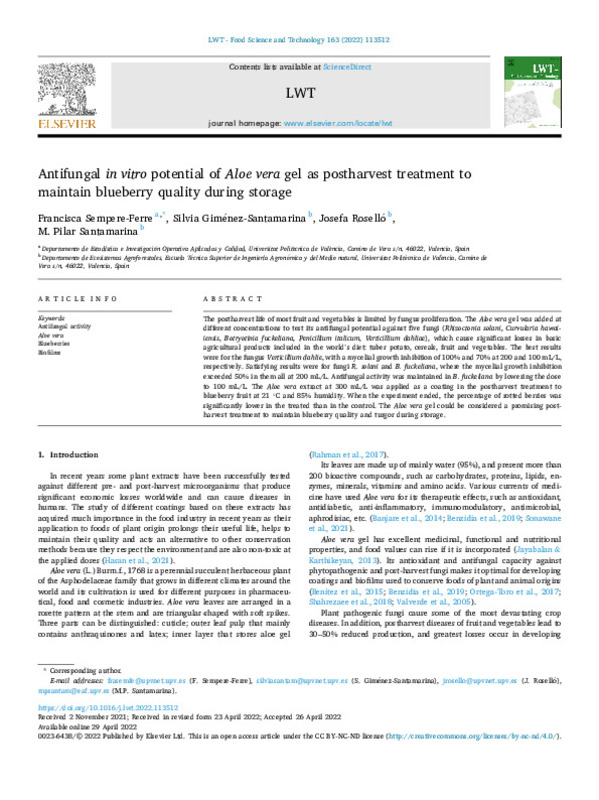JavaScript is disabled for your browser. Some features of this site may not work without it.
Buscar en RiuNet
Listar
Mi cuenta
Estadísticas
Ayuda RiuNet
Admin. UPV
Antifungal potential of Aloe vera in vitro and its use as preharvest treatment to maintain the quality of blueberries during storage
Mostrar el registro sencillo del ítem
Ficheros en el ítem
| dc.contributor.author | Sempere-Ferre, Francisca
|
es_ES |
| dc.contributor.author | Giménez-Santamarina, Silvia
|
es_ES |
| dc.contributor.author | Rosello Caselles, Josefa
|
es_ES |
| dc.contributor.author | Santamarina Siurana, M. Pilar
|
es_ES |
| dc.date.accessioned | 2022-11-28T19:01:58Z | |
| dc.date.available | 2022-11-28T19:01:58Z | |
| dc.date.issued | 2022-06-15 | es_ES |
| dc.identifier.issn | 0023-6438 | es_ES |
| dc.identifier.uri | http://hdl.handle.net/10251/190282 | |
| dc.description.abstract | [EN] The postharvest life of most fruit and vegetables is limited by fungus proliferation. The Aloe vera gel was added at different concentrations to test its antifungal potential against five fungi (Rhizoctonia solani, Curvularia hawaiiensis, Botryotinia fuckeliana, Penicillium italicum, Verticillium dahliae), which cause significant losses in basic agricultural products included in the world¿s diet: tuber potato, cereals, fruit and vegetables. The best results were for the fungus Verticillium dahlie, with a mycelial growth inhibition of 100% and 70% at 200 and 100 mL/L, respectively. Satisfying results were for fungi R. solani and B. fuckeliana, where the mycelial growth inhibition exceeded 50% in them all at 200 mL/L. Antifungal activity was maintained in B. fuckeliana by lowering the dose to 100 mL/L. The Aloe vera extract at 300 mL/L was applied as a coating in the postharvest treatment to blueberry fruit at 21 ¿C and 85% humidity. When the experiment ended, the percentage of rotted berries was significantly lower in the treated than in the control. The Aloe vera gel could be considered a promising postharvest treatment to maintain blueberry quality and turgor during storage. | es_ES |
| dc.language | Inglés | es_ES |
| dc.publisher | Elsevier | es_ES |
| dc.relation.ispartof | LWT - Food Science and Technology | es_ES |
| dc.rights | Reconocimiento - No comercial - Sin obra derivada (by-nc-nd) | es_ES |
| dc.subject | Antifungal activity | es_ES |
| dc.subject | Aloe vera | es_ES |
| dc.subject | Blueberries | es_ES |
| dc.subject | Biofilms | es_ES |
| dc.subject.classification | ESTADISTICA E INVESTIGACION OPERATIVA | es_ES |
| dc.subject.classification | BOTANICA | es_ES |
| dc.title | Antifungal potential of Aloe vera in vitro and its use as preharvest treatment to maintain the quality of blueberries during storage | es_ES |
| dc.type | Artículo | es_ES |
| dc.identifier.doi | 10.1016/j.lwt.2022.113512 | es_ES |
| dc.relation.projectID | info:eu-repo/grantAgreement/AEI//AGL2016-76699-R//MATERIALES BIODEGRADABLES MULTICAPA DE ALTA BARRERA PARA EL ENVASADO ACTIVO DE ALIMENTOS./ | es_ES |
| dc.rights.accessRights | Abierto | es_ES |
| dc.contributor.affiliation | Universitat Politècnica de València. Escuela Técnica Superior de Ingeniería Agronómica y del Medio Natural - Escola Tècnica Superior d'Enginyeria Agronòmica i del Medi Natural | es_ES |
| dc.contributor.affiliation | Universitat Politècnica de València. Facultad de Administración y Dirección de Empresas - Facultat d'Administració i Direcció d'Empreses | es_ES |
| dc.contributor.affiliation | Universitat Politècnica de València. Departamento de Ecosistemas Agroforestales - Departament d'Ecosistemes Agroforestals | es_ES |
| dc.description.bibliographicCitation | Sempere-Ferre, F.; Giménez-Santamarina, S.; Rosello Caselles, J.; Santamarina Siurana, MP. (2022). Antifungal potential of Aloe vera in vitro and its use as preharvest treatment to maintain the quality of blueberries during storage. LWT - Food Science and Technology. 163:1-9. https://doi.org/10.1016/j.lwt.2022.113512 | es_ES |
| dc.description.accrualMethod | S | es_ES |
| dc.relation.publisherversion | https://doi.org/10.1016/j.lwt.2022.113512 | es_ES |
| dc.description.upvformatpinicio | 1 | es_ES |
| dc.description.upvformatpfin | 9 | es_ES |
| dc.type.version | info:eu-repo/semantics/publishedVersion | es_ES |
| dc.description.volume | 163 | es_ES |
| dc.relation.pasarela | S\472673 | es_ES |
| dc.contributor.funder | AGENCIA ESTATAL DE INVESTIGACION | es_ES |
| dc.subject.ods | 02.- Poner fin al hambre, conseguir la seguridad alimentaria y una mejor nutrición, y promover la agricultura sostenible | es_ES |








